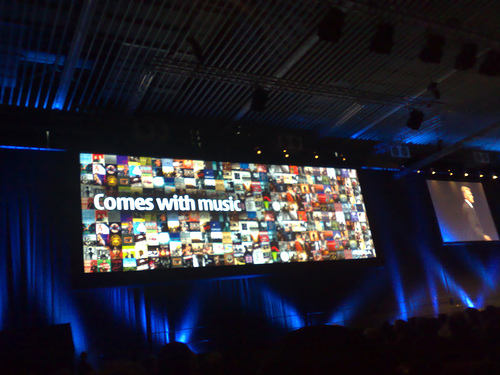The big music phones, such as the Nokia 5800, are not part of the Comes With Music service, at least in the UK. The marketing has been very visible, but the handsets have not been leaving the shop floor. Why has it not sold? Could it simply be the sales pitch of “Here you go mate, have the 5310 (a handest perceived to be rubbish) or an apparently out of style N95 8GB (despite Steve's enthusiasm for this, the High Street has moved on), and you can get your music for a year.”
At this point in the editorial conversation, Steve pitches in with “I bet it's because of the very restrictive DRM”, but I don't think this is the case. It's much more simple than that. People instinctively know that they either have a huge music collection in their computers at home, or they can get the music they want “from the internet”. There are no practical issues over DRM or acquisition issues over obtaining the music, they just know that the music is already 'there'. So why jump through the hoops of a manufacturer-specific have-to-buy-a-new-phone solution?

Nokia and the music industry talk about re-educating the public in how they pay for music, and make them comfortable in making that transaction, but the public have moved on and the music industry is still struggling to catch up. Their business models are under attack on the transition from physical sales to digital distribution. Unfortunately, Nokia's Comes with Music service has to negotiate and come up with a model that's agreeable to the Music Industry and the public. It appears from these numbers that at least one side of the equation has not held up to scrutiny.
And Nokia's continued refusal to discuss numbers is understandable from a political point of view, but they're now in a corner where they are dammed if they do, and dammed if they don't. What is clear is that Comes with Music is a burden.
Let's look at some of the other statements from Music Ally. In the first few weeks, Comes with Music customers are downloading 200 to 300 tracks. Okay, let's round that up to 1000 tracks in the first month, and then they download nothing else, because their collection is full. That's not true by the way, but we're being generous.
How much does all this cost Nokia? Again, a tough call, as there must be some discounting on the wholesale music track – don't forget the Nokia Music Store still sells music at the roughly under a pound a track. Lets assume there is a per track cost, and not a flat fee subscription (as the music gets to stay with the user when the year subscription runs out). So running some numbers at 5p per track we get a cost of the first month to Nokia of £50. That's on top of a bill of materials and a cut to the distributor and retailer of any handset.
Those 23,000-ish phones have cost Nokia £1,150,000.
Can someone, anyone, please come up with a valid business model that satisfies the handset manufacturer, the music industry, and the end user? And if not for 23,000 Nokia 5310 handsets, then for the estimated one million Nokia 5800 units that are being shipped per month? That device is the one that should be leading the Comes with Music charge, yet it's only available with the music subscription service in a handful of territories (Italy, Australia, etc).
All the music you can download, for a year, and you can keep it at the end of the year... We're always told that if offers on the internet look too good to be true, then you're not looking hard enough at the small print. In the case of Comes with Music, much of the print is safely locked up with the lawyers, and it's impossible to see if it really is working out for everyone.
What can be seen is a bit of a PR failure for Nokia. The question is, what do they do now? Can they even afford Comes with Music in a global recession that's squeezing their bottom line? And would it hurt them less to just scrap the project altogether?
-- Ewan Spence, April 2009
